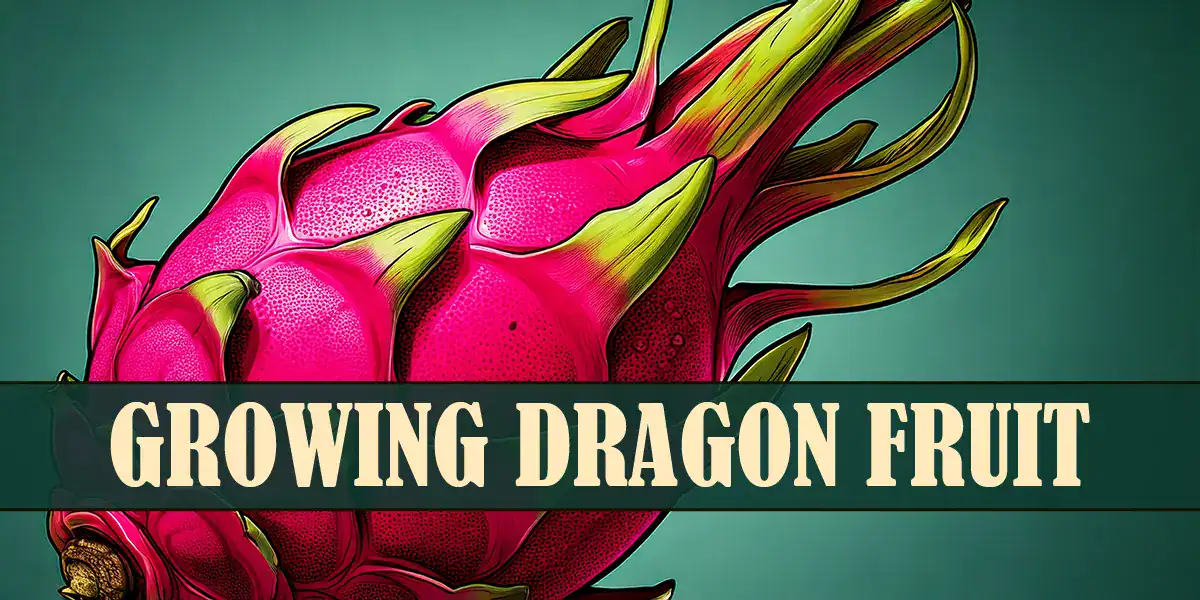Is there a perfect fruit?
It might be the dragon fruit, a Central American native that tastes like a cross between a kiwi and a pear or melon.
White-fleshed varieties are milder and refreshing. Red and purple-fleshed varieties are sweeter, with occasional hints of berry or grape.
Dragon fruit is a low-calorie, nutritional powerhouse packed with vitamin C, magnesium, and antioxidants.
The plant, a nocturnally blooming climbing cactus, can bear fruit in as little as 1 to 2 years. And it loves the hot and dry SoCal summers.
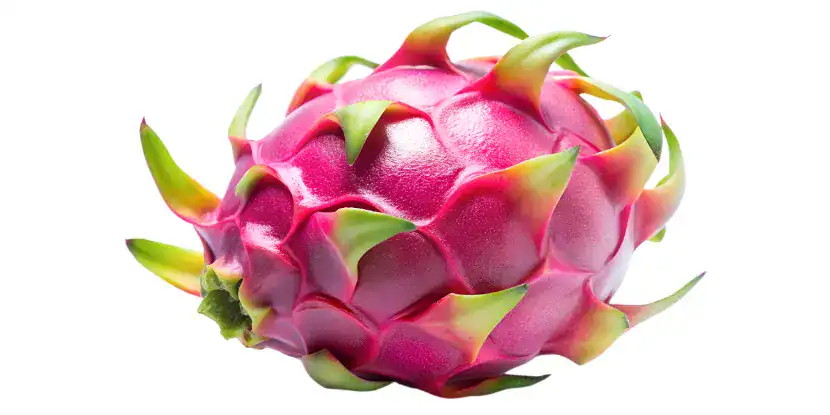
Close-up of a ripe dragon fruit.
The Dragon Fruit Flower
The dragon fruit flower is among the most unusual in the plant world.
- The tubular bloom can be 10–12 inches long, making it one of the largest for cacti.
- Petals are typically creamy white, sometimes with a faint yellow or greenish tint near the base.
- Outer petals are longer, slender, and may have a light green or pale pink hue, giving a layered, lotus-like effect.
- The inner petals are broader and more delicate, creating a soft, luminous center.
Fragrance
- The flower emits a strong, sweet fragrance, especially at night, to attract nocturnal pollinators like moths and bats.
- The scent is often described as a cross between jasmine and honeysuckle.
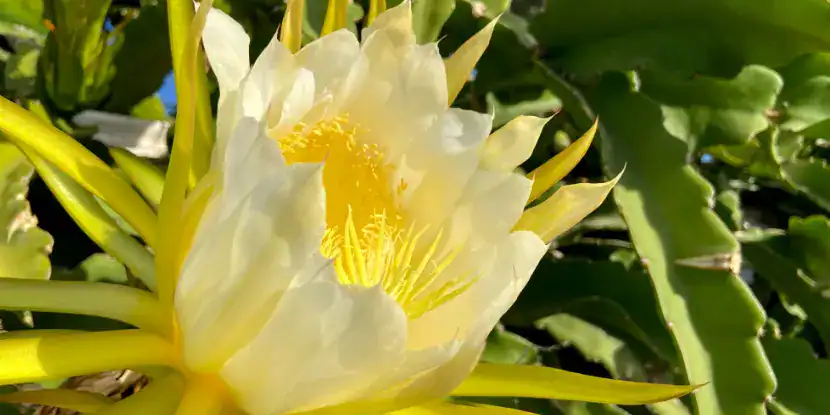
A luminous dragon fruit flower.
Blooming Habit
The flowers open at night and last just one night, closing by dawn. However, a dragon fruit plant blooms at various times throughout the growing season, not all at once, a pattern that allows for multiple flowering and fruiting cycles per year.
Many growers use hand pollination at night or early morning to ensure fruit production, especially when natural pollinators are absent.
Best Dragon Fruit Varieties for Southern California
Focus on varieties from the Hylocereus genus, which thrive in subtropical and dry regions.
- Hylocereus undatus: This is one of the most common and hardy dragon fruit varieties, known for its white flesh and pink skin.
- Hylocereus costaricensis: Produces bright red flesh with high sugar content, making for an exceptionally sweet fruit.
- Hylocereus megalanthus: Bears yellow fruit with flesh; smaller but highly aromatic.
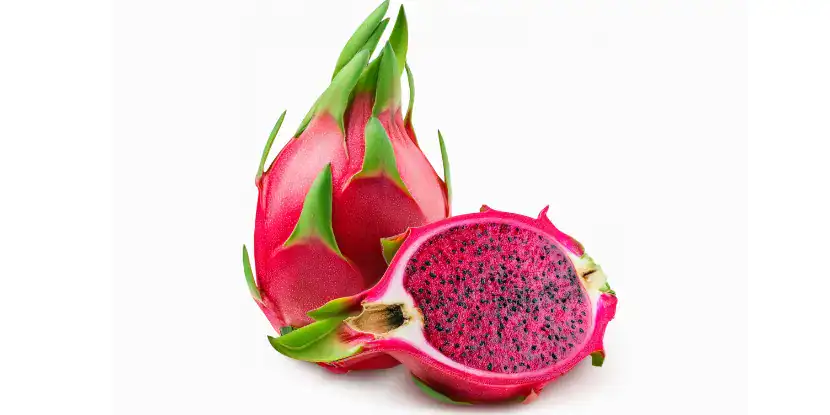
Red and purple-fleshed dragon fruits are sweeter and sometimes have hints of berry or grape.
Optimal Growing Conditions for Dragon Fruit
Light
- Dragon fruit plants need 6–8 hours of full sunlight daily.
- Choose a location with plenty of sun exposure, but protect young plants from scorching midday heat.
Temperature
- Dragon fruit grows best in temperatures between 65°F and 85°F.
- Mature plants can tolerate brief periods of colder or hotter weather, but prolonged temperatures below 32°F or above 100°F will stress or damage them.
Soil
- Dragon fruit prefers well-draining soil with a pH of 6 to 7.
- Sandy or loamy soils are ideal.
- Amend poor-draining soils with organic matter like compost or sand.

White-fleshed dragon fruits are mild and refreshing
Propagating Dragon Fruit
You can propagate dragon fruit plants from cuttings or seeds. Cuttings yield faster, more reliable results.
Cuttings
- Take a healthy stem cutting from a mature, disease-free dragon fruit plant.
- Allow the cutting to dry for a few days until the cut end forms a callus, which helps prevent rotting.
Seeds
- Extract seeds from a ripe dragon fruit and rinse them clean.
- Germinating dragon fruit seeds may take several weeks.
Planting Dragon Fruit
- Choose a location with plenty of sunlight and good drainage.
- Set up a sturdy trellis or post to support the plant as it matures.
- Insert the dragon fruit cutting or seedling into the soil, about 2–3 inches deep. Plant cuttings with the callused end down.
- Space multiple plants 6–8 feet apart to allow for growth.
- Water deeply after planting, but avoid waterlogging the soil.
- Add a layer of mulch to retain moisture and suppress weeds.

Dragon fruit hanging from a plant.
Dragon Fruit Care for Maximum Yield
Most healthy plants will bear fruit for 20–25 years.
Water
-
- Dragon fruit plants are drought-tolerant but perform best with consistent, moderate watering.
- Water deeply once or twice a week during the growing season, allowing the soil to dry between waterings.
- Reduce watering in winter when the plant goes dormant.
Fertilizer
- Feed your dragon fruit with a balanced fertilizer during the active growing season (spring through summer).
- Organic options like compost or well-aged manure can also boost growth.
- Avoid over-fertilizing, which encourages excessive vine growth with less fruit production.
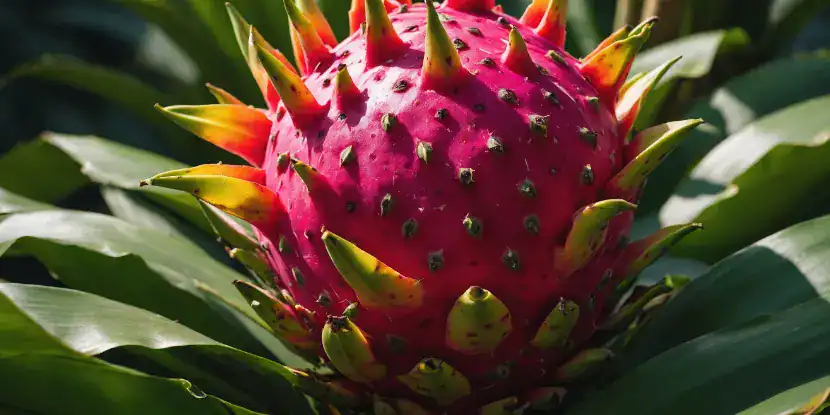
A plump dragon fruit surrounded by banana leaves.
Pests & Diseases
- Common pests include mealybugs and aphids, which can be treated with neem oil or insecticidal soap.
- Overwatering can lead to root rot, so monitor moisture levels.
Pruning
- Prune your dragon fruit plant to remove dead or overcrowded branches. This encourages airflow, reduces disease risk, and stimulates new growth.
- Regular pruning also helps manage the plant’s size and shape.
Harvesting and Storing the Fruit
Dragon fruit is ready to harvest when its skin turns bright, vibrant colors and feels slightly soft when pressed.
- Use sharp pruning shears to cut the fruit without damaging the stem.
- Store dragon fruit in the refrigerator for up to two weeks, or freeze the flesh for smoothies or desserts.
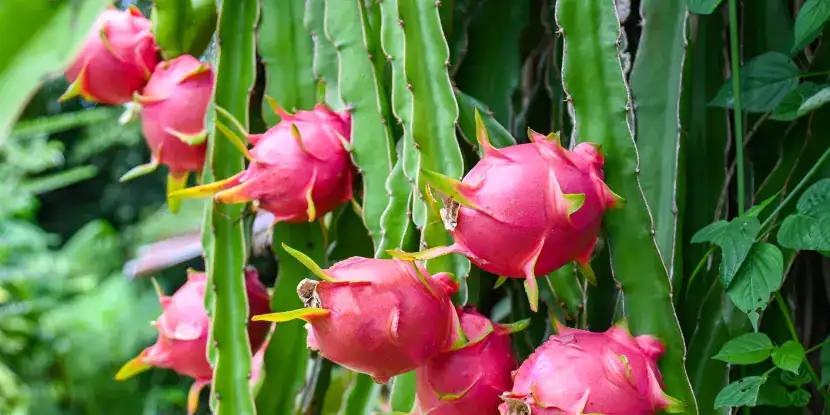
Dragon fruit maturing on a plant.
FAQs: Growing Dragon Fruit
Q: How long does it take to grow dragon fruit?
Cuttings can produce fruit in 6–8 months, or up to 2 years if grown from seed.
Q: Does dragon fruit need a lot of maintenance?
Dragon fruit is low-maintenance but benefits from consistent care, such as watering, pruning, and pest monitoring.
Q: Do I need to hand-pollinate dragon fruit flowers?
Some varieties require hand-pollination to set fruit. Night-blooming flowers need cross-pollination for the best results.
Q: Can dragon fruit grow indoors?
It’s possible with sufficient light (from a sunny window or grow lights) and a large container, but the plant does better outdoors.
Q: What type of trellis works best for dragon fruit?
A sturdy wooden or metal trellis is ideal, as dragon fruit vines are heavy and need strong support.
Q: Can I grow dragon fruit in a container?
Yes. Use a container at least 20 inches in diameter and depth, with proper drainage holes.
Q: Does dragon fruit bloom all year?
Dragon fruit typically blooms from summer through early fall in Southern California.
Are there thornless dragon fruit varieties?
Yes, some dragon fruit varieties, such as Hylocereus costaricensis, have minimal or no thorns.

